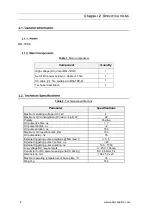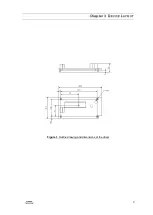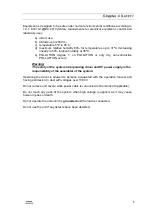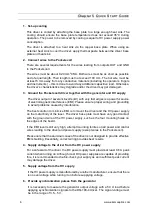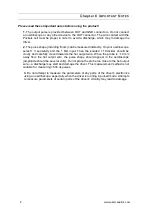
6
www.eksmaoptics.com
Chapter 5 Q
U IC K
S
T A R T
G
U ID E
1. Set-up cooling
This driver is cooled by attaching the base plate to a large enough heat sink. The
cooling should ensure the
base plate temperature does not exceed 35°C during
operation. The power to be removed by cooling is equal to HV power supply power
consumption.
The driver is attached to a heat sink via the copper base plate. When using an
external heat sink to cool the driver, apply thermal paste between the driver base
plate and heat sink.
2. Connect wires to the Pockels cell
There are several requirements for the wires leading from outputs OUT and GND
to the Pockels cell.
The wires must be about 0.24 mm
2
CSA. Both wires must be as short as possible
and of equal length. Their length must not exceed 100 mm. The hot wire must be
at least 5
mm away from any conductive materials (including the operator’s fingers
and instruments)
– this is done to avoid any additional capacitive load. Otherwise,
the driver’s characteristics may degrade and/or the driver may get damaged.
3. Ground the Pockels cell driver together with the generator and HV supply
The driver output of several kilovolts (kV) with very fast edges is a powerful source
of electromagnetic interference (EMI). Please ensure proper wiring and grounding
to avoid problems caused by interference.
The best solution to minimize EMI is to mount the driver and the HV power supply
on the metal body of the laser. The driver base plate must have very good contact
with the ground wire of the HV power supply, such as the four mounting holes on
the edges of the board.
If the EMI level is still very high, attempt mounting ferrites on all power and control
wires leading to the driver and power supply (except wires to the Pockels cell).
Please note that the aluminum case of the driver is not designed to provide effective
EMI shielding. Essentially, correct wiring provides best results.
4. Supply voltage to the driver from the DC power supply
For a safe start of the driver, the DC power supply must provide at least 0.6 A peak
current when turning on. Although most DC power supplies are capable of providing
this, it is recommended to double-check your supply as an insufficient peak current
may damage the driver.
5. Supply voltage from the HV supply
If the HV power supply is manufactured by another manufacturer, ensure that there
is no overvoltage while turning it on before supplying voltage.
6. Provide synchronization pulses from the generator
It is necessary to measure the generator output voltage with a 50
load before
applying synchronization signals to the DQ-100-4 driver. The signal voltage must
be in the range of 3.5…5 V.






